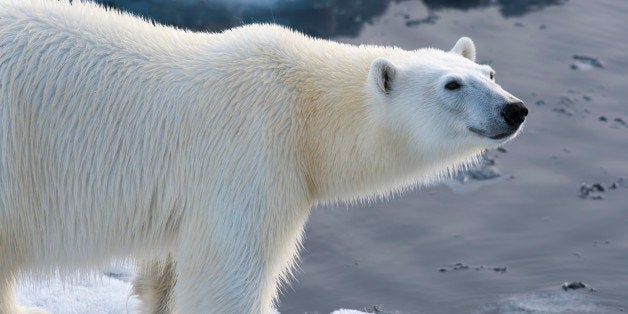
Two years ago, following guidance from the U.S. Geological Survey, the federal Fish and Wildlife Service officially listed the polar bear as a threatened species under the Endangered Species Act. The idea is that global warming will reduce--or even eliminate--sea ice in the Arctic Ocean at the end of summer, and this is where the bears go fishing.
But recent scientific findings (as well as some older ones) show that the polar bear has survived several millennia with little or no sea-ice. The ruling was clearly based upon less than the totality of science, and we should hope that the Survey's new chief, Suzette Kimball, who was schooled in the proud tradition of the Survey to put "science first," will see fit to advise the Fish and Wildlife Service to de-list the bears.
This Earth Day, it's time to give the polar bear the respect it deserves. Nothing humans can do to the climate is going to wipe it out.
That's because we can't change the Arctic as much as Nature has during the bear's existence.
Consider this: after the end of the most recent ice age, for three millennia, from around six to nine thousand years ago, the high arctic was nearly 13°F warmer in July than its 20 century average. We know this because there are trees buried in what is now barren tundra that carbon-date back to that era. During the warm era, the boreal forest (aka the "north woods") extended all the way to the Arctic Ocean and even onto the few islands that dot the sea. For the forest to exist, that's how much warmer it had to have been there during the summer.
According to the Geological Survey of Norway, "The Arctic Ocean may have been periodically ice-free" at this time. Martin Jakobsson of Stockholm University wrote in Quaternary Science Reviewsthat there were "periods of ice free summers in large parts of the central Arctic Ocean." And the polar bear survived.
Let's say humans could warm it up that much (which seems a bit of a stretch). We still couldn't sustain it for even one millennium -- more likely, at best a few hundred years. The likelihood that we will still be running on our current mix of energy one or two hundred years from now seems very low, given the historical record of energy evolution. That means the heat load that the polar bear tolerated after the end of the last ice age was about six times (assuming 500 years) what humans could foist upon them.
It gets even more interesting. Ice core data from Greenland reveals a very unstable climate from 12,700 to 14,700 years ago -- which is within the ice age. Christian Stranne and his colleagues writing in Quaternary Science Reviews in 2014[sciencedirect.com] (after the bear was listed) note that this period was punctuated with arctic ice oscillating from a permanent cover to periods without perennial cover. In other words, even in the end stage of the last ice age, the Arctic Ocean was ice-free at the end of summer for long periods. And the polar bear survived.
Temperatures at the end of the previous ice age were even warmer. Isotopes trapped in ice cores show that summer temperatures in Northwest Greenland averaged an astounding 11°F warmer than last century, for 6,000 yearsbeginning about 128,000 years ago. This was revealed in astounding 2013 Nature paper by Dorthe Dahl-Jensen and her team of ice drillers. That's beyond an order-of-magnitude more heat than humans could possibly unload on the ice. And the polar bear survived.
This very warm period is known as the Eemian thermal maximum. In 2010, Charlotte Lindqvist of State Univeristy of New York-Buffalo sequenced the DNA of an Alaskan bone fragment between 110,000 and 130,000 years old (i.e. in or near the Eemian) and found it to be that of -- yes -- a polar bear. "This means polar bears definitely persisted through warming periods during Earth's history," she said.
Just last year, Thomas Cronin (U.S. Geological Survey) and University of Alaska's Matthew Cronin, combining work on paleoclimate and molecular genetics, determined that there have been no extinctions of arctic marine mammals during the past 1.5 million years. That means the polar bear is highly adaptable, having survived multiple periods of integrated warming in the Arctic that dwarf what humans might accomplish.
Also, there's genetic evidence that when things get warm, the polar bear intermingles with the Alaskan brown bear, adaptably changing its way of life to accommodate a changing climate. So they're not even a separate species in the strict definition of the word. And when the arctic reverts to perennial ice, perhaps natural selection favors the white camouflage outfit.
Then there's the present. The largest and furthest-south polar bear population is in the Davis Straight, off of northeast and eastern Canada. It stretches all the way down to Newfoundland. With warming, one would think that the southern populations should be the most vulnerable, but, according to Environment Canada, the population there is growing.
The polar bear seems pretty tough, having survived long stretches where the Arctic Ice was likely gone at the end of summer. It survived the heat of the beginning of the previous interglacial, which was much warmer than the beginning of this one, which itself was much warmer over time than we can make it.
It's high time for the Geological Survey to go back to "science first" and advise Fish and Wildlife to take it off the "threatened" list. "Happy Earth Day" to the polar bear!